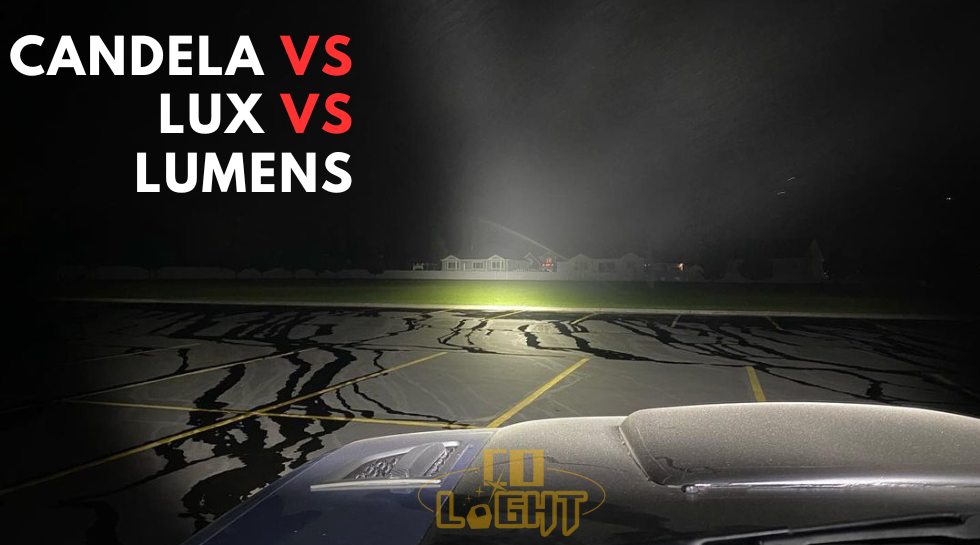La iluminación juega un papel fundamental en nuestras vidas, desde iluminar nuestros hogares hasta guiarnos con seguridad en la carretera. Sin embargo, ¿alguna vez te preguntaste cómo medimos y cuantificamos la luz? Aquí es donde los lúmenes, lux y candelas entran en escena.
Esto sucede a menudo. Cuando estás eligiendo una bombilla o un faro para tu coche, en la descripción de una lámpara se indican lúmenes, en otra lux y en la última candelas. Uno se pregunta por qué nadie utiliza el mismo sistema para medir estas cosas y puede hacer conjeturas sobre otras luces de coche. En resumen, todas son normas independientes para medir diferentes efectos de iluminación.
Ya sea que sea un entusiasta de la iluminación o alguien simplemente curioso sobre la ciencia detrás de la luz, este blog le dirá qué son lúmenes , lux y candelas y las diferencias entre ellos.
Lúmenes
El lumen es una unidad que se utiliza para medir la potencia luminosa total o la potencia radiante de una fuente de luz, y representa la cantidad total de luz visible emitida por la fuente. Se utiliza para describir el brillo de la luz. Esta cifra suele ser proporcionada por el propio fabricante del chip LED, como Cree, Philips u Osram. La clasificación de lúmenes es simplemente una medida del potencial bruto de la luz y no tiene en cuenta ningún otro factor en el diseño y la ingeniería de la luz, como la geometría y el tamaño de los reflectores, la claridad de las lentes y varios otros factores. Por ejemplo, dos luces con la misma salida de lúmenes pueden tener diferencias en la eficiencia eléctrica, la claridad de las lentes y el tamaño y la geometría de los reflectores, lo que da como resultado diferentes salidas.
Lujo
El lux es una unidad que se utiliza para medir la iluminancia de un área específica. Representa la intensidad de la luz de una fuente de luz que cae sobre una superficie a una distancia determinada, y se utiliza normalmente para describir el nivel de iluminación. El lux se encuentra en el extremo opuesto del espectro de los lúmenes y se refiere a la cantidad real de luz que llega a una superficie desde una distancia específica. El lux se mide a menudo en un metro cuadrado de una pared a una distancia de 10 metros. Por ejemplo, tome una sola fuente de luz y proyecte su luz sobre una pared mientras garantiza una distancia de 10 metros entre ellas. A continuación, mida la salida de lux en un metro cuadrado de esa pared.
Como ejemplo, considere un foco con un haz muy concentrado, que tiene un punto focal muy brillante. Esto daría como resultado un valor lux alto, lo que indica que la luz se proyecta a una gran distancia. Por el contrario, las luces como los reflectores, que tienen un ángulo de haz más amplio, pueden tener valores lux más bajos, no porque su calidad de luz sea peor, sino porque su propósito de diseño es distribuir la luz sobre un área más amplia. El lux es, por lo tanto, un método excelente para medir la calidad de la luz.
Candela
Candela (Cd) es una unidad utilizada para medir la intensidad de una fuente de luz en una dirección específica, normalmente se utiliza para describir la intensidad de focos o fuentes de luz direccionales.
La distinción clave entre lúmenes y candelas radica en que los lúmenes representan la emisión total de luz visible, mientras que las candelas representan la emisión o intensidad de la luz en una dirección particular. Un dato interesante sobre las candelas es que también se las conoce como potencia de vela, y una vela real tiene una clasificación de candelas muy apropiada.
Comparación
1. Si dos fuentes de luz tienen el mismo valor de lúmenes pero una de ellas tiene un valor de candelas más alto, significa que la fuente de luz tiene una mayor intensidad de luz en una dirección específica. Esto puede dar lugar a las siguientes situaciones:
-
Foco más potente: una fuente de luz con un valor de candela más alto puede enfocar mejor la luz, creando un efecto de foco más intenso. Esto es muy útil en aplicaciones que requieren iluminación direccional o de larga distancia, como reflectores o linternas.
-
Iluminación de alto contraste: las fuentes de luz con valores altos de candelas pueden producir un haz de luz más intenso, lo que crea un mayor contraste entre los objetos o áreas y su entorno circundante. Esto es fundamental para aplicaciones que requieren resaltar áreas u objetos específicos, como la iluminación de escenarios o la iluminación de vallas publicitarias al aire libre.
Es importante tener en cuenta que el valor de candela solo describe la intensidad de la fuente de luz en una dirección específica y no considera el área de cobertura ni la uniformidad de la iluminación. Por lo tanto, al seleccionar una fuente de luz, debe considerar tanto los valores de lúmenes como de candela para asegurarse de que cumplan con los requisitos de iluminación de su aplicación específica.
2. Si dos fuentes de luz tienen los mismos valores de lúmenes y candelas, pero una de ellas tiene un valor de lux más alto, significa que la fuente de luz produce una mayor iluminancia a una determinada distancia. En situaciones específicas:
-
Iluminación más brillante: un valor de lux más alto indica que la luz es más intensa y puede iluminar un área con más brillo a la misma distancia.
-
Iluminación más uniforme: si dos fuentes de luz tienen los mismos valores de lúmenes y candelas, pero una tiene un valor de lux más alto, puede proporcionar una iluminación más uniforme. Esto significa que la distribución de la luz dentro del área iluminada es más consistente, lo que evita una iluminación desigual.
-
Mayor nivel de iluminancia: si necesita lograr un mayor nivel de iluminación en un área específica, una fuente de luz con un valor de lux más alto puede ser una mejor opción porque puede proporcionar una iluminación más intensa.
Vale la pena señalar que el valor de lux depende de la distancia a la que se encuentre la fuente de luz. Por lo tanto, al comparar los valores de lux de dos fuentes de luz, asegúrese de considerar su rendimiento a la misma distancia. El lux es un parámetro importante para evaluar la iluminancia y puede ayudarlo a elegir la fuente de luz adecuada para sus necesidades de iluminación específicas.
Una buena manera de recordar las diferencias entre términos es:
- Los lúmenes son la cantidad de luz que se emite.
- Lux es el brillo que tendrá tu superficie.
- La candela mide la intensidad visible de la fuente de luz.
Por lo tanto, comprender estos tres términos es muy útil, ya que nos ayudan a cuantificar la potencia luminosa total. Cuando necesite comprar luces todoterreno, le ayudará a analizar el rendimiento de las luces. Si tiene más ideas, ¡no dude en compartirlas con nosotros!



